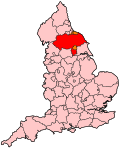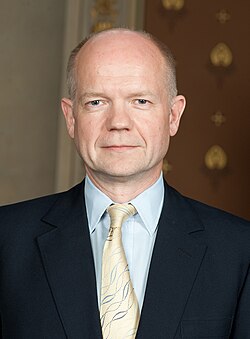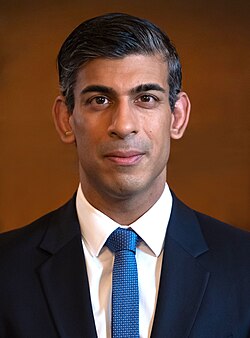History
Richmond was one of the parliamentary boroughs in the Unreformed House of Commons that dates to the middle of its long existence, first being represented in 1585. Medieval royal charters had specifically exempted the town from sending members to Parliament; [4] at the time this was often seen as an expensive burden.
By the early eighteenth century it was controlled by the Yorke and Darcy families, who each nominated a member; the Darcys gained control in the 1760s and shortly afterwards the interest was purchased by Sir Lawrence Dundas, 1st Baronet, along with the Aske estate. [5] The Dundases or their nominees would retain control of the borough's representation for many years; there was no contested election between 1722 and 1839 and then not another until 1866. The last Dundas family member would not retire from the seat until 1885. During this period the seat was a safe one for the Whigs and later the Liberals; since around 1918 it has been a safe seat for the Conservative Party, with majorities often more than 40%.
From 1983 the seat was represented by the cabinet minister Leon Brittan, after boundary changes saw his Cleveland and Whitby seat abolished; however he resigned from the Commons in December 1988 in order to take up the position of vice-president of the European Commission.
1989 by-election
The ensuing by-election, in February 1989, was won by William Hague: it was the last by-election won by a Conservative candidate during the Conservative Governments of 1979–1997. Hague's win has been attributed in part to the decision by the remnants of the Social Democratic Party (those members that objected to the merger with the Liberal Party the previous year) to contest the election as well as the newly merged Social and Liberal Democrats (who subsequently renamed themselves the Liberal Democrats). The SDP candidate, local farmer Mike Potter, came second, and Hague's majority of 2,634 was considerably smaller than the number of votes (11,589) for the SLD candidate, Barbara Pearce. Despite the Labour landslide of 1997, they did not come close to winning the seat, which stayed Conservative with a majority of 10,000. Hague retained the seat at every general election from then on, building the Conservative majority to 23,336, until his decision to step down at the 2015 election.
1992 change in main opposition candidate
In 1992 the Labour candidate until a few weeks before the election, David Abrahams, was deselected following a series of rows within the local party over his personal life and business interests. It emerged in 2007 that he used the name "David Martin" when dealing with tenants in his various rental properties in the Newcastle area, [6] and that he had claimed that he lived with his wife and son, though he had never been married. Divorcee Anthea Bailey later told a local newspaper she and her 11-year-old son had posed as Mr Abrahams' family as part of a business arrangement so that Abrahams could create "the right impression". [7] [8]
2001–2024
At the 2001 general election Richmond became the Conservatives' safest seat in the UK, both in terms of the actual numerical majority and by percentage, the seat being held by William Hague, then the Conservative leader. Although the numerical majority was surpassed by Buckingham at the 2005 election, Richmond has a smaller electorate and had a greater proportion of Conservative voters so retained the second-largest percentage majority. Again in 2010, Richmond was the safest Conservative seat in the country in terms of numerical and percentage majority, [9] though by 2019 it had slipped out of the top 15 safest Conservative seats. [10] It has been represented since May 2015 by Rishi Sunak, the former Prime Minister of the United Kingdom and leader of the Conservative Party. [2]
Boundaries

Map of 2010–2024 boundaries
1918–1950: The Borough of Richmond, the Urban Districts of Kirklington-cum-Upsland, Masham, and Northallerton, and the Rural Districts of Aysgarth, Bedale, Croft, Leyburn, Northallerton, Reeth, Richmond, Startforth, and Stokesley.
1950–1955: The Borough of Richmond, the Urban District of Northallerton, and the Rural Districts of Aysgarth, Croft, Leyburn, Masham, Northallerton, Reeth, Richmond, Startforth, and Stokesley.
1955–1974: As prior but with redrawn boundaries.
1974–1983: As prior but with redrawn boundaries.
1983–1997: The District of Richmondshire, and the District of Hambleton wards of Appleton Wiske, Bedale, Brompton, Broughton and Greenhow, Carlton Miniott, Crakehall, Great Ayton, Hillside, Leeming, Leeming Bar, Morton-on-Swale, Northallerton North East, Northallerton South East, Northallerton West, Osmotherley, Romanby, Romanby Broomfield, Rudby, Sowerby, Stokesley, Swainby, Tanfield, The Cowtons, The Thorntons, Thirsk, Topcliffe, and Whitestonecliffe.
1997–2010: The District of Richmondshire, and the District of Hambleton wards of Appleton Wiske, Brompton, Broughton and Greenhow, Great Ayton, Leeming Bar, Morton-on-Swale, Northallerton North East, Northallerton South East, Northallerton West, Osmotherley, Romanby, Romanby Broomfield, Rudby, Stokesley, Swainby, and The Cowtons.
2010–2024: The District of Richmondshire, and the former District of Hambleton wards of Bedale, Brompton, Broughton and Greenhow, Cowtons, Crakehall, Great Ayton, Leeming, Leeming Bar, Morton-on-Swale, Northallerton Broomfield, Northallerton Central, Northallerton North, Osmotherley, Romanby, Rudby, Stokesley, Swainby, and Tanfield.
The Richmond constituency covered the Richmondshire district and the northern part of the former Hambleton District. It is a mostly affluent rural area with a significant commuter population, covering parts of the North York Moors and Yorkshire Dales National Parks, including Wensleydale and Swaledale. It contained the market towns of Northallerton, Richmond, Leyburn, Bedale, Hawes and Stokesley, along with Great Ayton and other villages. It also includes the largest army base in Europe, Catterick Garrison.









